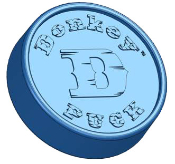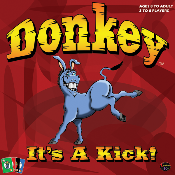| Publisher | Cleveland Kids |
| Art Credits | GHOST Graphic Designs |
| Game Contents | 108 cards (54 Playing, 54 Kicker), seven plastic pucks, stack of score sheets, instructions |
| Guidelines | Fast-Play Card Game |
| MSRP | $24.99 |
| Reviewer | Andy Vetromile |
You know those tables you see at game gatherings where everyone is in rapt attention to what’s going on, and sometimes a roar of laughter goes up from that group? Stop by and there’s a good chance Donkey It’s a Kick! is being played.
Game play is pretty straightforward. There are plastic pucks in the middle of the table for all but one person. Everyone begins with a hand of four cards and the dealer puts the rest of the deck in front of him. When he’s ready he starts drawing cards. If he likes what he pulls he substitutes it for one of his four hand cards; otherwise he discards what he drew. Regardless, the castoff goes onto the table between him and the player to his left. That player draws from this smaller pile to draft cards just as the dealer did.
In this fashion the cards make their way around the table and into (or through) everyone’s hands. The cards are like a standard deck except 1s replace aces and the two jokers are wild. When someone has four of a kind (four 10s, four kings, etc.), he grabs one of the disks. That’s the signal for everyone else to try to snatch one as well, but like a game of musical chairs someone is left without a puck. That unfortunate soul has earned the D in “donkey.” It’s perfectly acceptable to fake a grab for a puck – if anyone falls for this ploy, the first person to touch a disk is penalized with a letter just the same.
That’s the signal for everyone else to try to snatch one as well, but like a game of musical chairs someone is left without a puck. That unfortunate soul has earned the D in “donkey.” It’s perfectly acceptable to fake a grab for a puck – if anyone falls for this ploy, the first person to touch a disk is penalized with a letter just the same.
To make things worse, the game adds in a Kicker every round. A card from this deck changes things up a bit. It might affect the play of the game, distract the players, or alter the triggering condition for success. Perhaps the players must get four of the same color. They may be required to hum a tune throughout the round as chosen by the dealer. It could be physical, like grabbing the disk with your chin. Or it might be as simple as forcing everyone to announce which number card they pass. Failure to do so means the perpetrator gets another letter – he could end up with two strikes in one turn, or two players might both get penalized.
Once someone has earned all the letters in “DONKEY” he becomes a Donkey; he can no longer win the game. (This barring other unforeseen circumstances – donkeys may become players again in this unpredictable little dance.) He keeps on playing, though, because his new mission is to be as big a distraction to the remaining contenders as possible. If he gets four of a kind he shows his hand and announces “Donkey!” with the usual resulting chaos amid the table, but he himself can’t grab a puck. He can’t touch his fellow players, but anyone tricked into speaking to him is turned into a Donkey as well.
(This barring other unforeseen circumstances – donkeys may become players again in this unpredictable little dance.) He keeps on playing, though, because his new mission is to be as big a distraction to the remaining contenders as possible. If he gets four of a kind he shows his hand and announces “Donkey!” with the usual resulting chaos amid the table, but he himself can’t grab a puck. He can’t touch his fellow players, but anyone tricked into speaking to him is turned into a Donkey as well.
When all but two players have become Donkeys there’s a Showdown. Each person gets half the deck, deals his opponent four cards, and they play without a Kicker to get four of a kind and win one last puck.
Donkey is graphically pleasing, but then there’s not much to illustrate here – the cards are bright and easy to read, and that’s the most important thing when trying to sort through them to find your match. The score sheets are kind of stacked up in the box (the next printing is supposed to have a pad); these show a row for players’ names across the top and the word “donkey,” one letter per line, running down the left side. The rules say to give everyone their own sheet even though there’s space for four people on one sheet. (Perhaps they expect you to play four games – in which case you’d still only need to put your name at the top once.) It’s a bit of an extravagance when you could just use scrap paper (bring your own pen in any case) or even simply remember who has what (assuming you trust your opponents to tell you).
The insert tries to keep everything in place, but it’s still easy for things to rattle around loose or even get under the cardboard. (The reprint is also supposed to switch to a plastic insert.) The most notable feature by far, though, are the pucks. About two and a half inches across and three-quarters of an inch thick, these aptly named items are made of sturdy plastic and are fun to stack, clatter, slide, spin, roll from player to player, play table hockey, and occasionally use in a game of Donkey It’s a Kick! It would be nice if the cards were as unyielding – they get quite a workout as they circumnavigate the table – but they hold up pretty well considering, and some card sleeves might alleviate the worst of it if the players are willing to trade slippery for sturdy.
If your pregnant wife has ever gone into labor in the middle of the night and you were left to look for your car keys and cell phone in a pile of stuff on your desk in the dark so you could get to the hospital, you have a pretty good idea what it’s like to start flipping through a deck of cards in Donkey to make four of a kind. The grunts of frustration and clenched-teeth curses flow into that metaphor pretty seamlessly as well. There’s no shortage of crazy card-snapping games on the market, but the addition of the cleverly coined Kickers keeps things fresh not just one round after another but one game to the next. You aren’t likely to see all the cards in just a game or two, and even then many of them require creative input from the players when they come up. Furthermore, expansions are planned to add Kickers to your set.
This is one of those games your friends go to great lengths to tell you how much they disliked . . . then when you show up the next week, demand to know why you didn’t bring that crazy Donkey game again this time. While it’s too adrenalin-fueled for most players to keep at this the whole night, it straddles the line between card game and party game (then again, it also straddles the line between controlled chaos and a bloodsport). This makes Donkey It’s a Kick!a good choice whether it’s a session with gung-ho gamers or just a soiree with friends or family and their casual interest in the brutal world of donkey-kicking.
